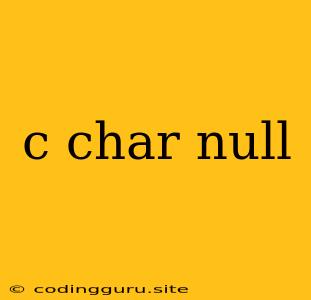Understanding the Null Character in C
The C programming language is known for its flexibility and efficiency. One key element contributing to its power is the concept of the null character, often denoted by '\0'. This character plays a crucial role in various aspects of C programming, particularly when dealing with strings.
Why is the Null Character Important?
In C, strings are not inherently defined as a separate data type. They are essentially arrays of characters. However, this poses a challenge: how does the compiler know where a string ends? This is where the null character steps in. The null character acts as a terminator, signaling the end of a string.
How Does the Null Character Work?
Let's take a simple example:
char name[] = "John";
When this code is compiled, the array name will be allocated memory to store the characters 'J', 'o', 'h', 'n', and finally, the null character '\0'. The null character is automatically appended by the compiler, marking the end of the string.
The Null Character and String Manipulation
The presence of the null character allows for efficient string manipulation in C. Functions like strcpy, strcat, and strlen rely heavily on the null character to determine the boundaries of a string.
Example: strlen Function
The strlen function calculates the length of a string by iterating through the array until it encounters the null character. Let's see an example:
#include
#include
int main() {
char str[] = "Hello";
int length = strlen(str);
printf("The length of the string is: %d\n", length);
return 0;
}
In this example, strlen will return the value 5, as it counts the characters from 'H' to 'o' before reaching the null character.
Common Mistakes and Solutions
One common error is forgetting to include the null character when manually creating strings. For instance, if you were to create a string like this:
char greeting[] = "Hello World";
Without the null character, the compiler would not know where the string ends. This could lead to unexpected behavior in functions like printf or strcpy.
Solution:
Always ensure you allocate enough memory for your string array and manually append the null character at the end, or utilize the strcpy function for automatic null character inclusion.
Understanding the Null Character's Value
The null character, '\0', is represented by the ASCII code 0. This means it has a numerical value of 0. This value is distinct from the character '0', which has an ASCII value of 48.
The Null Character in File Handling
The null character is also used in file handling, particularly when working with file names. Certain operating systems use the null character to delimit file names within a string. This allows for storing multiple file names within a single string.
Conclusion
The null character is a fundamental concept in C programming, enabling efficient string manipulation and providing clear delimitation for strings. Understanding its role and proper usage is crucial for writing accurate and reliable C code. By mastering the use of the null character, you can leverage the full potential of the C programming language.
